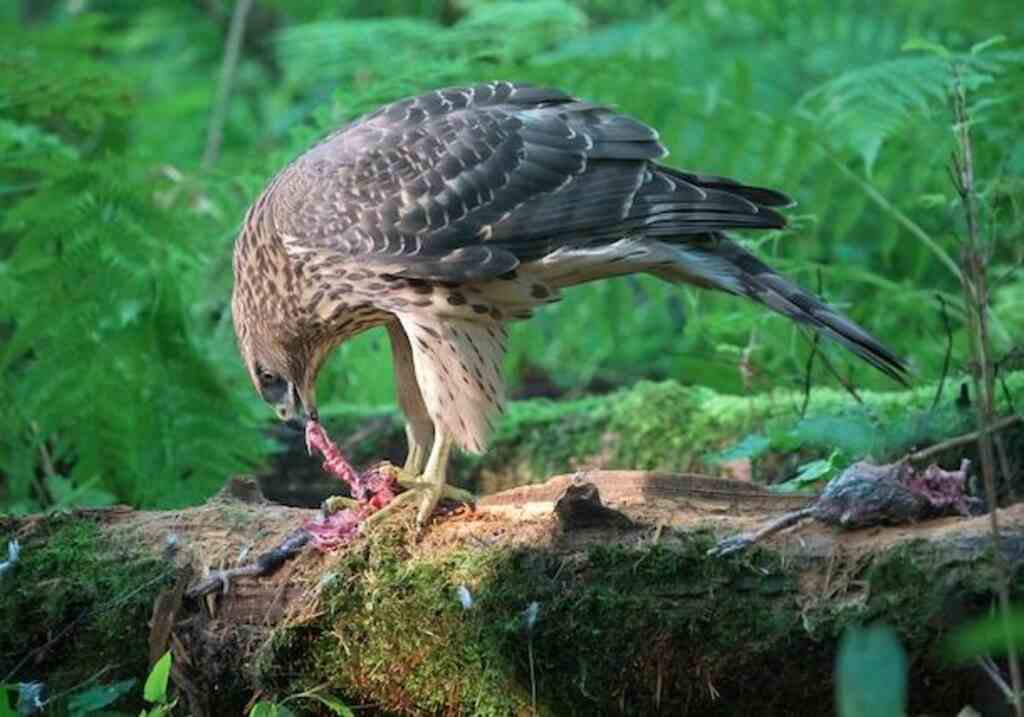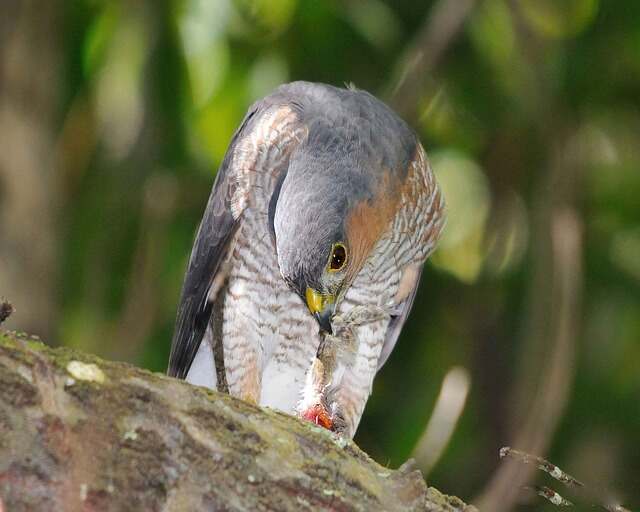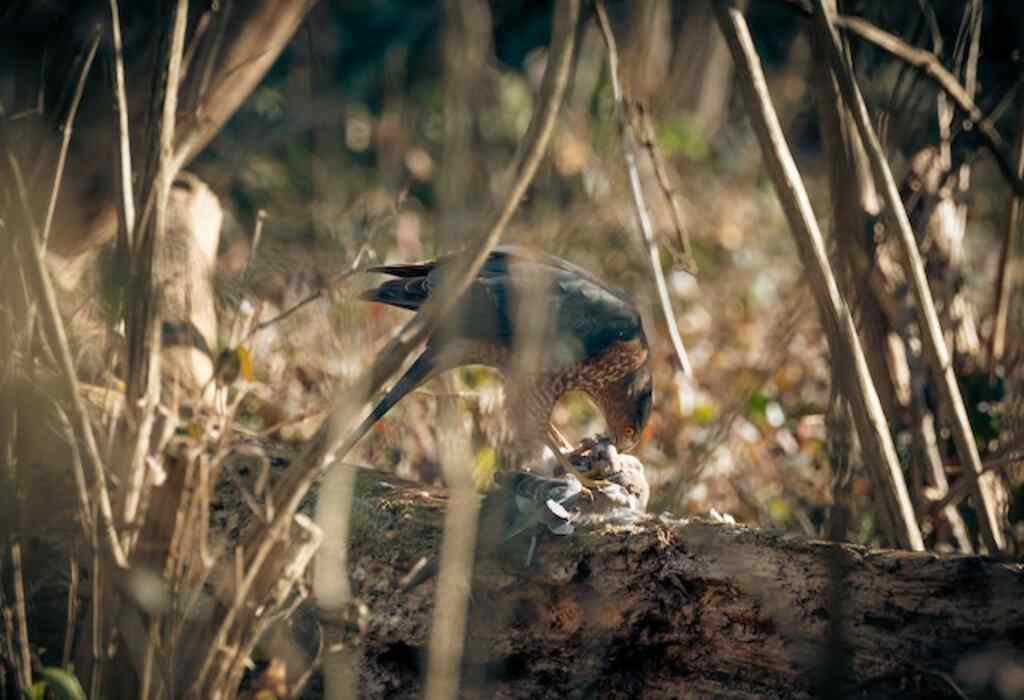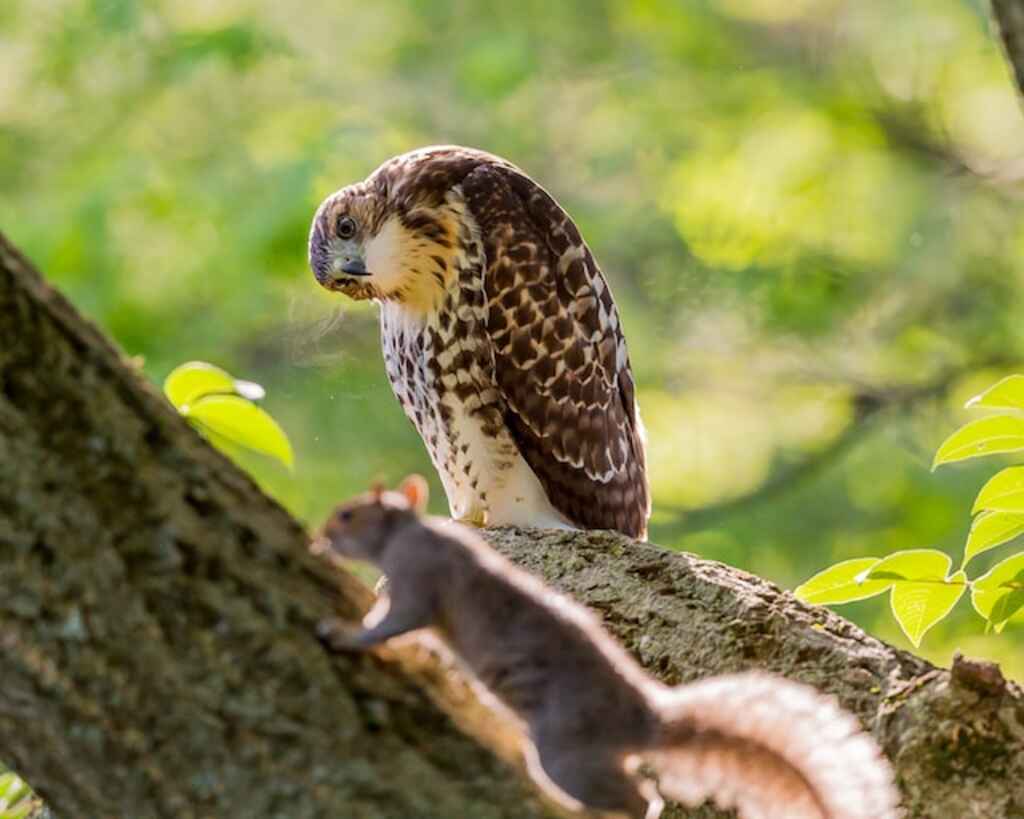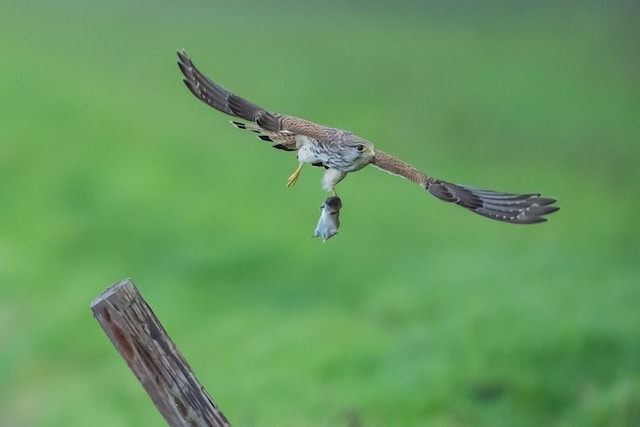What do hawks eat in the city? Pigeons? Squirrels? Maybe…your neighbor’s cat?
These fascinating creatures, known for their strength, power, and freedom, have not only conquered the skies but also embraced urban life.
Join us as we unravel the culinary secrets of these city-dwelling hawks, who have seamlessly integrated into our concrete jungles, becoming a vital part of urban wildlife populations.
Get ready for a beak-to-talon revelation!
Table of Contents
- 1 Overview of Hawk Diet
- 2 What Do Hawks Eat In The City?
- 3 Challenges for Urban Hawks
- 4 Unique Finds
- 5 Conclusion
- 6 FAQs: What Do Hawks Eat in the City
- 6.1 What types of prey do hawks typically target in urban environments?
- 6.2 How do hawks hunt their prey in an urban environment?
- 6.3 Do hawks eat domestic pets like cats or small dogs in the city?
- 6.4 What are some common signs of hawks hunting in the city?
- 6.5 Are hawks beneficial for managing urban pests like rats and pigeons?
- 6.6 Are there any risks associated with hawks hunting in the city?
- 6.7 What can be done to attract hawks to urban areas?
- 6.8 Can hawks adapt their diet to urban environments?
- 6.9 How can we ensure the conservation of hawks and their prey in the city?
- 6.10 What should I do if I encounter an injured or distressed hawk in the city?
- 7 Author
Explanation of Hawks in the City
Hawks that live in cities are typically known as urban hawks. They are a relatively new phenomenon and are not native to city environments.
Urbanization has led to the creation of habitat for these birds that is different from their natural one. The reasons why hawks thrive in cities vary depending on location.
For instance, some cities have large parks and green spaces with plenty of prey for them to hunt while others have tall buildings which provide excellent nesting sites.
The most common hawk species found living in North American cities include Red-tailed Hawks, Cooper’s Hawks, Sharp-shinned Hawks, and American Kestrel.
Importance of Understanding What They Eat
Understanding what urban hawks eat is vital because it helps us comprehend how they interact with their environment.
Their diet also sheds light on other aspects such as predator-prey relationships and how pollution affects them.
In addition, their diet reflects changes in the city environment due to human activities such as deforestation or construction.
Their ability to adapt to these changes is crucial for their survival.
Last but not least, understanding what they eat allows us to maintain balance between hawk populations and other wildlife population levels, thus ensuring that our ecosystem remains healthy and sustainable for all species involved.
Overview of Hawk Diet
Hawks are birds of prey that belong to the family Accipitridae. They are known for their sharp talons and hooked beaks, which are used to catch and kill their prey.
Hawks are carnivorous birds that feed primarily on other animals. Their diet is diverse and varies depending on their habitat, size, and species.
General diet of hawks
The general diet of hawks consists of small mammals, birds, reptiles, and amphibians. The most common prey items for hawks include mice, voles, rabbits, snakes, lizards, and insects.
Larger hawks such as the Red-tailed Hawk may also eat squirrels or rabbits. Hawks have a varied diet because they are skilled hunters that can adapt to different environments.
In addition to hunting live prey, some hawks also feed on carrion or dead animals. This is especially true for larger species such as Bald Eagles that may scavenge for food in addition to hunting live prey.
Differences in diet between urban and rural hawks
The diet of urban hawks differs from that of rural or wild hawks due to the availability of food sources in different environments.
Urban areas provide a unique environment for hawks because they offer a variety of food sources not found in rural areas.
Urban hawks have been observed feeding on small mammals such as rats or squirrels, along with birds like pigeons or starlings that thrive in city environments due to the abundance of food waste.
Additionally, some urban hawks have been known to hunt pets such as small dogs or cats.
However, unlike their rural counterparts who rely mostly on live prey hunted from natural habitats like forests or grasslands where they nest;
Urban Hawks also consume plenty of human-provided foods, including garbage scraps from dumpsters near fast-food restaurants; making up a significant portion of their diet.
Overall, the diet of hawks is diverse and varies depending on environmental factors like habitat and food availability.
Urban hawks have adapted to their surroundings and developed unique feeding habits that differ from those of rural hawks.
What Do Hawks Eat In The City?
In the city, hawks feed on a variety of prey. Common urban hawk diet includes pigeons, squirrels, rats, and small birds. They adapt their hunting techniques to urban environments.
Understanding their diet helps us appreciate their role in urban ecosystems and highlights the importance of preserving natural habitats for hawks and their prey.
Prey in the City
Common Prey Found in the City
Hawks that reside in the city often rely on a different set of prey items than their rural counterparts. While many prey species overlap between urban and rural areas, there are certain prey types that are exclusive to city life. Pigeons, squirrels, rats, and small birds are all common prey items found in urban hawk diets.
Pigeons
Pigeons are one of the most abundant bird species found in cities, making them an easy target for hawks. These birds often gather in large flocks and can be found roosting on buildings or feeding on scraps of food left behind by humans.
Hawks will often perch themselves high up on a building or tree and wait for an opportunity to swoop down and catch a pigeon as it takes flight.
Squirrels
Squirrels are another common prey item for hawks living in cities. These small mammals can be found scampering around parks and gardens, climbing trees or snacking on nuts.
Hawks have developed specialized techniques to catch squirrels while flying through dense urban environments. They use their sharp talons to grasp onto squirrels while flying at high speeds.
Rats
Rats may not be a popular choice among humans, but they make up a significant portion of urban hawk diets. These rodents can be found scavenging through trash cans or hiding out in alleyways during the day.
Since they tend to stay low to the ground, hawks have developed hunting strategies that involve skimming over rooftops or diving into alleyways to catch rats off guard.
Small Birds
Small birds such as sparrows and finches are also commonly hunted by urban hawks. These birds can be seen darting among trees or feeding on bird feeders in backyards.
Hawks have learned to use their speed and agility to catch these quick-moving prey items. They often chase them through trees and other obstacles, using their sharp talons to grab them out of the air.
How Hawks Hunt Their Prey in an Urban Environment
Hawks living in cities have adapted their hunting techniques to take advantage of the unique opportunities presented by urban environments.
Since many prey items are smaller and more agile in the city, hawks must be able to maneuver quickly through tight spaces while still maintaining control over their prey.
They use their keen eyesight to spot potential targets from a distance, then swoop down quickly for the catch.
Overall, hawks that live in the city rely on a variety of prey items that are unique to urban environments.
By understanding what these birds eat and how they hunt, we can gain insight into how wildlife adapts and thrives among humans in our increasingly urbanized world.
Challenges for Urban Hawks
Competition with other predators for food sources
Hawks in an urban environment have to compete with a variety of other predators for their food sources. Domestic cats, raccoons, and even other bird species can all prey on the same animals as hawks do.
This competition can make it difficult for hawks to find enough food to survive. One way that hawks have adapted to this competition is by changing their hunting habits.
Instead of hunting during the day like they would in rural areas, many urban hawks have become nocturnal hunters.
This allows them to avoid direct competition with other predators and increases their chances of finding prey.
Another adaptation that has been observed in some urban hawks is a change in diet.
For example, instead of feeding solely on birds or rodents, some hawks have started eating insects or fish as a way to diversify their food sources and reduce competition with other predators.
Exposure to toxins and pollution from city life
Living in a city comes with its fair share of hazards, including exposure to toxins and pollution. Hawks are particularly susceptible to these dangers due to their position at the top of the food chain.
Studies have found that urban hawks often have higher concentrations of heavy metals like lead and mercury in their bodies than rural counterparts.
These metals can accumulate over time and cause health problems such as kidney damage, anemia, or even death.
In addition to heavy metals, pollutants such as pesticides can also pose a threat to urban hawks.
These chemicals can cause reproductive problems or weaken the immune system, making the birds more vulnerable to disease.
To combat these threats, researchers suggest that efforts be made to reduce pollution levels within cities where possible.
Additionally, wildlife rehabilitation centers can help injured, or sick birds recover from exposure-related illnesses.
Unique Finds
Surprising Prey Items Found in Urban Hawk Diets
Urban hawks have shown to be more adaptable than rural hawks when it comes to their diet.
Due to the limited availability of natural prey, city-dwelling hawks have been known to hunt a variety of animals beyond their typical diet.
The urban landscape provides unique opportunities for these birds of prey, leading them to consume some unexpected prey items.
Rabbits and Other Small Mammals
While rabbits and other small mammals are not uncommon in rural hawk diets, they are not typically found in urban environments.
However, studies have found that some city-dwelling hawks have adapted their diets to include these smaller mammals as a primary food source.
This may be due to the abundance of green spaces such as parks and gardens that provide habitat for these animals.
One study conducted in New York City found that red-tailed hawks preyed on eastern cottontail rabbits and gray squirrels at a higher rate than previously thought.
In some cases, they even targeted juvenile raccoons and opossums, which are strange finds for an urban hawk’s diet.
Fish from Water Sources Within the City
Fish may not be the first thing that comes to mind when thinking about what do hawks eat in the city. However, certain species of hawks such as ospreys have been known to hunt fish from water sources within urban areas.
They will patrol bodies of water such as rivers and lakes searching for fish near the surface before diving at incredible speed with talons poised.
One fascinating example is the pair of ospreys nesting atop a crane overlooking a construction site near Miami International Airport, where they regularly catch fish from nearby bodies of water, including Bluegill Sunfish and Largemouth Bass.
Insects, Reptiles, and Amphibians
While it may be surprising to learn that hawks prey on insects, reptiles and amphibians, these animals are often found in abundance in urban environments.
Hawks have been known to hunt small reptiles such as snakes and lizards, as well as amphibians like frogs near water sources.
Insects such as grasshoppers and cicadas can also make up a significant portion of an urban hawk’s diet. They have even been observed catching butterflies mid-flight with their sharp talons.
Overall, the adaptability of hawks when it comes to their diet is quite impressive.
The range of prey items that they consume in urban environments is varied and diverse, reflecting the changing face of many cities around the world, where natural habitats are shrinking for both humans and wildlife.
Conclusion
Summary of What Do Hawks Eat in the City
Hawks living in urban environments have adapted their diet to include a variety of prey species found within the city. While their natural habitat may have been replaced by concrete and buildings, they have found a way to survive and thrive.
Common prey items include pigeons, squirrels, rats, and small birds. However, hawks in the city have also been known to eat rabbits and other small mammals, fish from water sources within the city, as well as insects, reptiles, and amphibians.
Thanks to their keen eyesight and hunting instincts honed over millions of years of evolution, hawks are able to survive even in busy cities with plenty of human activity.
They can be seen perching on tall buildings or flying high above city streets scanning for potential prey.
Importance of Preserving Natural Habitats for Hawks and Their Prey
It is important to remember that despite their adaptability to urban environments, hawks still require natural habitats with diverse ecosystems for sustained survival.
Destruction of these habitats is often caused by human development such as construction or deforestation, which reduces prey availability for hawks.
Ongoing conservation efforts are necessary to ensure their survival alongside other wildlife species that share similar habitat requirements.
As urban populations continue to grow worldwide, it has become increasingly crucial that people learn about urban wildlife such as hawks s, so they can coexist peacefully.
By preserving natural habitats for both predator (hawks) and prey species (squirrels & pigeons), we will be taking significant steps towards maintaining a healthy ecosystem within our cities whilst ensuring the continuation of all types of wildlife within our beautiful planet Earth!
FAQs: What Do Hawks Eat in the City
What types of prey do hawks typically target in urban environments?
Hawks in the city primarily target small to medium-sized prey such as pigeons, squirrels, rats, and small birds. Their diet may also include surprising items like rabbits, fish from water sources, insects, reptiles, and amphibians.
How do hawks hunt their prey in an urban environment?
Hawks use a combination of perching, soaring, and agile flight to hunt their prey in the city. They often perch on trees, buildings, or other structures, scanning the surroundings for potential prey and then swooping down swiftly to catch their target.
Do hawks eat domestic pets like cats or small dogs in the city?
Hawks generally do not target domestic pets as their primary prey. However, small pets left unattended outside may be at risk, so it’s advisable to supervise them or provide appropriate shelter to ensure their safety.
What are some common signs of hawks hunting in the city?
Observable signs of hawks hunting in urban areas include sudden commotion among smaller birds, persistent circling in the sky, or the presence of scattered feathers in an area where a hunt might have occurred.
Are hawks beneficial for managing urban pests like rats and pigeons?
Yes, hawks play a beneficial role in controlling urban pest populations. By preying on rodents and pigeons, hawks help maintain a balance in the ecosystem and reduce the need for chemical pest control methods.
Are there any risks associated with hawks hunting in the city?
While hawks generally pose no direct threat to humans, there is a slight risk of incidents like minor injuries or startled encounters if they feel threatened or are provoked. It is important to observe hawks from a distance and respect their natural behavior.
What can be done to attract hawks to urban areas?
Creating a habitat-friendly environment by providing nesting platforms, suitable perching spots, and maintaining green spaces with diverse prey populations can attract hawks to urban areas. However, it is essential to prioritize their natural habitat preservation.
Can hawks adapt their diet to urban environments?
Yes, hawks have shown adaptability in their diet and hunting strategies to thrive in urban environments. They have learned to exploit available food sources and make the most of the opportunities provided by the cityscape.
How can we ensure the conservation of hawks and their prey in the city?
Conservation efforts should focus on preserving natural habitats, protecting green spaces, and minimizing pollution and toxins in urban areas. Educating the community about the importance of coexisting with urban wildlife and supporting local conservation organizations can also contribute to their preservation.
What should I do if I encounter an injured or distressed hawk in the city?
If you come across an injured or distressed hawk, it’s best to contact local wildlife rehabilitation centers or animal control agencies. They have the expertise to handle and provide appropriate care for injured hawks and ensure their well-being.


